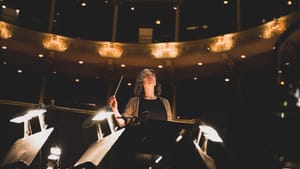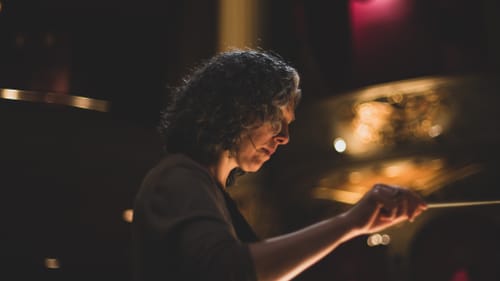Stay in the Loop
BSR publishes on a weekly schedule, with an email newsletter every Wednesday and Thursday morning. There’s no paywall, and subscribing is always free.
Tchaikovsky: The music behind the ballet
The PA Ballet's music director shares orchestral secrets of ‘The Nutcracker’

My earliest memory is of my dad putting The Nutracker on the turntable. He would tell us the story of the little girl and her nutcracker prince in the Land of Sweets, and we kids would galumph around the house imagining we were snowflakes and sugar plum fairies. Stage fright put an end to my ballet career at the age of three and a half, but I never outgrew my first love. So I leapt at the chance to talk with the Pennsylvania Ballet’s music director, Beatrice Jona Affron, about Tchaikovsky’s glorious music.
A true believer
Affron first experienced The Nutcracker in the 1940 animated Disney film Fantasia, though the piece remained on the periphery of her conducting repertoire until she joined the Pennsylvania Ballet. “The first time I saw the Nutcracker ballet was in December 1992 here at the Academy of Music,” she remembered. She was in her early twenties and had been hired as an assistant conductor.
Happily, Affron has become a true Tchaikovsky believer. “Oh, I am so grateful for it,” she said of the Nutcracker: “The beautiful colors in the sounds and the strange combinations of instruments that he infused throughout the score.” The composer pairs high and low instruments, such as tuba with triangle, playing with the possibilities of the orchestra and expanding our idea of what an orchestra can do.
The first act loves the orchestra
The ballet opens on a party at an affluent 19th-century home, and Tchaikovsky gives us nostalgic social dances, including the Grandfather Dance, a minuet that pays homage to the Rococo period. But while act 1 tells the story part of The Nutcracker, it also highlights the orchestra with three long stretches in which the music comes to the fore.
There’s the Overture, of course, but the second musical highlight comes after the party scene. The lights dim and the violin solo begins. “It’s a solo from Sleeping Beauty,” Affron explained. “Balanchine loved that solo,” but it’s rarely performed in Sleeping Beauty. Instead, he excerpted it and added it to The Nutcracker: “there’s a long period of time with nothing going on onstage and the audience is just listening to this gorgeous violin solo.” In these performances, concertmaster Luigi Mazzocchi and assistant concertmaster Dana Anderson Hepler trade off solo duties.
The third orchestral moment—Affron’s favorite—comes after the battle with the mice. Marie lies sleeping and the great snow scene has not yet begun. “The bed is just sort of gliding around the stage and … it’s really the orchestra’s moment to be featured in some of the most beautiful music of the evening.”
All the music is beautiful, of course, but Affron explained why this was so special. “It’s a really simple tune, but the way he varies it and makes it richer and fuller to the point of explosion is so skillful and so touching. It is just a very joyous moment to do for the orchestra.”
Fairy magic
The Waltz of the Snowflakes, which ends act 1, marks the transition to the dream world, and it is the longest dance in the ballet. It puts the spotlight on the corps, but it also challenges the orchestra. “It’s very complicated and contrapuntal and you see that on stage as well,” Affron said. “There are still moments in Waltz of the Snowflakes where I have to be just as alert today as I was the first time I conducted it.”

In act 2, Tchaikovsky introduces the Dance of the Sugar Plum Fairy with the sound of a celesta, played by the company’s principal pianist, Martha Koeneman. The instrument was new in Tchaikovsky’s day—this was the first use of a celesta in any major piece of music, and it remains the most recognizable in the repertoire. The sound seems to conjure the tiptoe of fairy magic.
The genius of tempo and key
Tchaikovsky’s pacing came up again and again in our conversation. In the national dances, Affron says, “Tchaikovsky takes us on a trip through tempo, from the lively Spanish dance to the slow and sultry Arabian dance. The Chinese dance is lively again.”
The rise and fall from dance to dance becomes a rhythm of its own that draws us through the sequence to Mother Ginger: “There’s this big, joyful, goofy, crazy guy in drag on stilts before we concentrate on these gorgeous formations and the beautiful subtlety of the waltz [of the Flowers], and then the Pas de Deux,” Affron explains.
When I asked how Tchaikovsky managed to draw us in emotionally, Affron had the same answer: pacing. “If he presents a melody in one key, he knows how much time to spend in that key before modulating to another key … There isn’t a single person who doesn’t feel lifted up by this harmonic motion. He absolutely understood how long to pull on that thread without letting it break, and then giving us a new thread. And all of those things, I think, for the average listener are visceral, but very powerful.”
The Pas de Deux is another example, Affron says. “It’s a G-major scale, over and over again, but he reharmonizes it, and varies it, and knows when to bring us to a particular key and then to bring us to yet another key, and then to bring us back home.” The music takes us on “an enormous journey without even having that much thematic material to get us there … That’s what great composers do, right?”
What, When, Where
The Pennsylvania Ballet’s Nutcracker runs through December 31 at the Academy of Music, 240 S. Broad St., Philadelphia. (215) 893-1999 or paballet.org.
The Academy of Music is a wheelchair-accessible venue. For more information about the accessibility of Kimmel campus venues, call Patron Services at (215) 893-1999 / (215) 875-7633 TTY or email [email protected].
Sign up for our newsletter
All of the week's new articles, all in one place. Sign up for the free weekly BSR newsletters, and don't miss a conversation.

 Camille Bacon-Smith
Camille Bacon-Smith